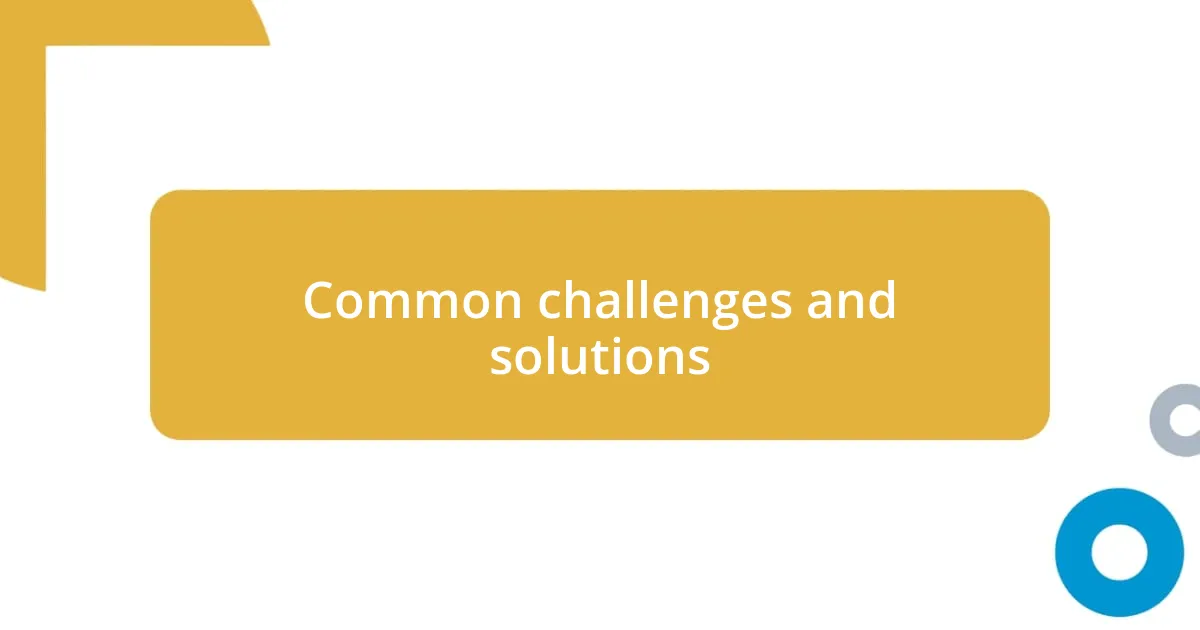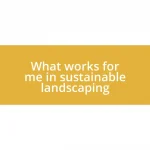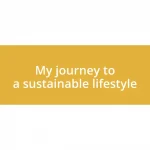Key takeaways:
- Sustainable building certifications like LEED, BREEAM, and Green Globes provide frameworks for environmentally responsible choices, focusing on various sustainability aspects such as energy efficiency and occupant well-being.
- Achieving certification involves a structured process, including pre-assessment, team assembly, and regular progress tracking to address challenges creatively.
- Preparation for certification audits is crucial, including conducting mock audits, developing checklists, and ensuring all documentation is in order to build confidence for the actual audit.
- Common challenges in navigating certifications can be overcome through organization, team collaboration, and leveraging technology for efficient data tracking and monitoring post-certification compliance.

Understanding sustainable building certifications
Navigating sustainable building certifications can be a bit overwhelming at first. I remember my initial encounter with LEED (Leadership in Energy and Environmental Design) — it felt like stepping into a maze of criteria and points. It made me wonder, how can we really measure sustainability? These certifications serve as frameworks that guide project owners and developers in making environmentally responsible choices, and although they can seem complex, they’re essential for promoting green practices.
Have you ever paused to think about the true impact of our buildings? Certifications like BREEAM (Building Research Establishment Environmental Assessment Method) and Green Globes focus not just on energy efficiency but on overall environmental responsibility. I find it fascinating how these programs evaluate a building’s sustainability across various categories, from water use to indoor air quality. It’s like a report card that holds all of us accountable for our choices.
As you dive deeper into these certifications, consider how they align with your values or projects. Personally, I’ve seen how buildings that sought certification not only improved their environmental footprint but also enhanced occupant satisfaction. The emotional payoff of knowing that your work contributes to a healthier planet is truly fulfilling. Isn’t that what sustainability is all about? It’s about creating spaces that nurture both people and the planet.

Key certification programs overview
When it comes to key certification programs, understanding their distinct approaches can make a significant difference in your project’s sustainability journey. Each program offers a unique perspective on what it means to build responsibly. For instance, I’ve experienced firsthand the meticulous process of achieving LEED certification, where every decision—from materials to energy use—is scrutinized through a sustainability lens. It felt akin to a treasure hunt, searching for points that would ultimately reflect the building’s environmental integrity.
Here’s a brief overview of the key certification programs:
-
LEED (Leadership in Energy and Environmental Design): Developed by the U.S. Green Building Council, it assesses energy savings, water efficiency, and overall environmental quality.
-
BREEAM (Building Research Establishment Environmental Assessment Method): Originating in the UK, this program focuses on sustainable value and building performance, evaluating areas like ecosystem impact and waste management.
-
Green Globes: An American certification that emphasizes a more flexible approach, allowing projects to assess their sustainable features through an online questionnaire.
-
Energy Star: Primarily focused on energy efficiency, this certification provides a straightforward way for building owners to benchmark their energy use against similar structures.
-
WELL Building Standard: Concentrating on the health and well-being of occupants, this certification assesses aspects like air quality and natural lighting.
I still remember the excitement of receiving our Green Globes certification. It felt like a badge of honor, symbolizing not just compliance but also a commitment to my community’s health—an emotional reminder that every consideration counts towards a larger purpose.

Steps to achieve certification
Achieving sustainable building certification is a structured journey that often begins with a clear understanding of the specific requirements of the certification program you choose. For me, conducting a thorough pre-assessment was crucial. It’s like mapping out your route before hitting the road. You want to know what challenges lie ahead and identify the best strategies to tackle them, ensuring you’re set up for success from the start.
Once the pre-assessment is done, I recommend assembling a committed project team. This step is vital because collaboration multiplies the expertise and passion for sustainability. I recall one project where we brought together architects, engineers, and sustainability consultants. The synergy we developed was both inspiring and energizing! This kind of teamwork ensures that everyone is aligned with the project’s goals and can contribute effectively to the overarching vision of sustainability.
As you move forward, regular progress tracking and adjustments are essential. I’ve learned that what works in theory might encounter challenges in practice. One project involved unexpected supply chain issues that could have derailed our timeline. By applying some creative problem-solving and staying flexible, we adapted and kept moving toward our certification goal. It’s all about resilience and commitment to sustainable practices that reflect your values and aspirations.
| Step | Description |
|---|---|
| Pre-Assessment | Evaluate certification requirements and potential strategies for your project. |
| Team Assembly | Gather a diverse project team to bring expertise and alignment toward common sustainability goals. |
| Progress Tracking | Regularly monitor advancements and adjust plans to tackle emerging challenges and stay on course. |

Preparing for certification audits
Preparing for a certification audit can sometimes feel like preparing for a performance, where every detail counts. I vividly recall the weeks leading up to our last LEED audit. The team and I spent countless hours reviewing documentation, ensuring that everything was in order, from waste management records to energy consumption logs. Have you ever felt the weight of anticipation before a big event? That was precisely how I felt, knowing that our commitment to sustainability was on the line.
It’s essential to conduct mock audits to build confidence and familiarity with the process, adjusting for any potential weaknesses. In one instance, we organized a practice audit with external experts, simulating the real experience. Their feedback was eye-opening. It’s fascinating how an outside perspective can illuminate areas you might have overlooked. It turned out we needed to tighten up our air quality monitoring—something I hadn’t initially considered critical but soon recognized as vital.
Finally, I suggest creating a detailed checklist for all necessary documentation and practices, serving as your roadmap during the audit. Having everything laid out made me feel more in control and ready. It’s like packing your bag before a journey; when you know you have everything you need, your confidence soars. By the time the auditor arrived, I felt a mix of excitement and assurance that we were ready to showcase our work and dedication to sustainable building practices.

Best practices for sustainable design
Sustainable design begins with a deep engagement in site selection. I remember a project where we took the extra time to study the local ecology before deciding where to build. It was enlightening to see how choosing a location that minimized disturbance to native habitats not only supported local wildlife but also enriched the overall community and enhanced the project’s sustainability credentials. As I reflect on this, I often ask myself: how can our choices today benefit the ecosystem for generations to come?
Another best practice involves integrating energy-efficient technologies from the get-go. On one particular project, we opted for high-performance windows and solar panels. The initial investment felt daunting, but seeing the reduction in energy costs and the positive feedback from clients made it all worthwhile. Have you ever experienced that moment of realization when an investment pays off in unexpected ways? I cherish those moments because they reaffirm my belief in prioritizing sustainability even when it challenges conventional thinking.
Moreover, biophilic design is a powerful approach to creating spaces that foster a connection with nature. In my own experience, incorporating natural light and greenery transformed a sterile office into a vibrant, welcoming space. It was incredible to witness the boost in mood and productivity among the staff after we added plants and expanded windows. How often do we overlook the profound impact our surroundings have on our well-being? This aspect of sustainable design goes beyond mere aesthetics; it cultivates environments that enhance quality of life, and it keeps me motivated in my pursuit of sustainable building practices.

Common challenges and solutions
Navigating sustainable building certifications often presents its own set of challenges, especially when gathering the necessary documentation. I recall a project where we struggled to compile all the required paperwork on time. Realizing this need for organization, we developed a centralized system for document storage, which significantly streamlined our process. Have you ever experienced chaos in managing project files? Creating a clear structure not only alleviated our stress but also made us more efficient in tracking progress toward certification.
Another challenge I faced was the ambiguity in understanding certification requirements. It can feel a bit like deciphering a complex code. To overcome this, I started creating a glossary of terms and requirements as I learned them, and I even involved the entire team in weekly review sessions. These collaborative discussions not only clarified confusion but also fostered a sense of shared responsibility. Don’t you think that when everyone is on the same page, it can transform project dynamics for the better?
One of the most daunting aspects I encountered was the need for consistent monitoring and reporting post-certification. Initially, I felt overwhelmed by the responsibility of ensuring ongoing compliance. However, I realized that leveraging technology—like sustainability management software—could simplify data tracking. This shift not only made my life easier but also allowed our team to focus on innovative solutions rather than drowning in paperwork. There’s a certain empowerment in adopting tools that elevate our sustainability goals, don’t you think? Embracing technology turned out to be a game-changer for us.














